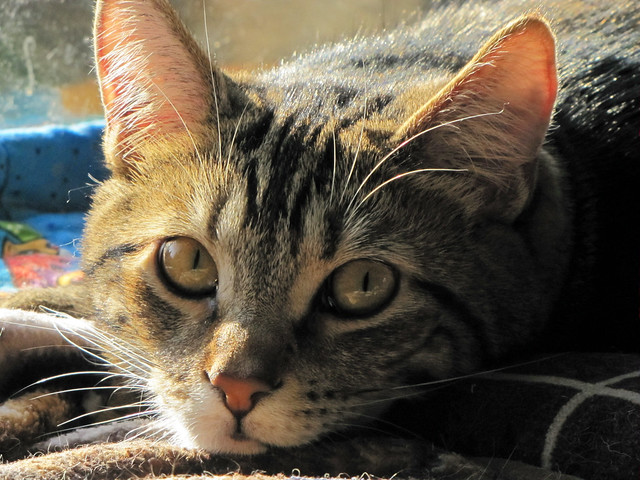Just a quick reminder to all the Canadian readers of Kayak Yak that Monday May 2 is the federal election. Let's see a good turnout at the polls, people!
For anyone still making up their minds on how to vote, there's a platform comparison tool on the CBC website. Go check out the various party stands on the environment and other issues of interest to kayakers, such as... well, everything.
And another reminder, that voting is just the first step in democracy. Another important element is participating in decisions made by local government, and in May the residents of the Capital Regional District have some chances to do that again.
The CRD is hosting a series of Community Consultations about their new Regional Parks Strategic Plan. Pop over to the CRD website and take a look at the draft Plan, which is the product of a year and a half's work with a Citizen Advisory Panel and employees. Some of the parks affected by the plan are used by kayakers and small boat users. This is the time to see what the CRD is thinking of doing for our parks, and to say what we want for our future.
Here's the schedule for the Community Consultations, copied from the CRD website:
May 3 Victoria – Da Vinci Centre, 195 Bay Street (Upper Room)
May 4 Westshore – Juan de Fuca Rec Centre, 1767 Island Highway (Kinsmen Fieldhouse)
May 5 Saanich Peninsula – Central Saanich Cultural Centre, 1209 Clarke Road (Lower Room), Brentwood Bay
May 10 Sooke – Community Hall, 2037 Shields Road (Lower Hall)
May 11 Salt Spring Island, 145 Vesuvius Bay Road (Portlock Park – Meeting Room)
Southern Gulf Island residents: public meetings will be held on Galiano, Mayne, Pender and Saturna islands in May. Watch for details on this website and in local newspapers.
Meeting Times: 6 – 7pm Open house
7 – 9pm Presentation and facilitated discussion
Unable to attend a meeting? Go to the online feedback form and express an opinion.
Saturday, April 30, 2011
Friday, April 29, 2011
Royal Wedding Commemorative Paddle
Ah, a morning with a difference: I turned on the television as soon as I got up. And as I expected, the Canadian news did not fail me. There were the highlights of the Royal Wedding... gown, fine suits, carriage and Bentleys and a hot convertible Austin minor. Dashing gents and smiling ladies. And a fine romantic kiss on the balcony in front of a crowd that numbered over a million. Well done. I drank Earl Grey tea out of a bone china teacup and ate a fine breakfast before taking my kayak out for a quick trip round Stein Island and back. Bloody good morning, all told.
Thursday, April 28, 2011
Thetis Lake News Release
Hot off the presses -- we've just received a news release from the Capital Regional District (CRD) Parks that will be of interest to anyone who paddles in Thetis Lake this month. Here's the news about how we who use the lake can co-operate with the Salmon Enhancement Program, basically by not launching our kayaks at the main beach during a salmon fry release.
Media Advisory
For Immediate Release
April 28, 2011
Public Cooperation Sought as Students Release Salmon Fry into Thetis Lake
Victoria, BC – The Capital Regional District is requesting the public’s assistance and cooperation in treating the main beach area at Thetis Lake Regional Park as a quiet zone from
April 29 - May 31, 2011.
Fisheries and Ocean Canada has acquired a temporary permit allowing students to release
salmon fry from their classroom projects into Thetis Lake. This is due to the recent fuel spill in
Goldstream River, which damaged the fry’s home stream and compromised that watershed as
healthy habitat for aquatic organisms.
CRD Regional Parks is requesting that the public not disturb the waterfront area if a release is in
progress. Dog owners are requested to use a different beach when a release is underway, and
to keep dogs under control and away from the students and shore.
For further information, please contact:
Laurie Sthamann, Communicatio Coordinator
CRD Regional Parks
Tel: 250.360.3332 | cell: 250.889.8030
lsthamann@crd.bc.ca
www.crd.bc.ca/parks
Media Advisory
For Immediate Release
April 28, 2011
Public Cooperation Sought as Students Release Salmon Fry into Thetis Lake
Victoria, BC – The Capital Regional District is requesting the public’s assistance and cooperation in treating the main beach area at Thetis Lake Regional Park as a quiet zone from
April 29 - May 31, 2011.
Fisheries and Ocean Canada has acquired a temporary permit allowing students to release
salmon fry from their classroom projects into Thetis Lake. This is due to the recent fuel spill in
Goldstream River, which damaged the fry’s home stream and compromised that watershed as
healthy habitat for aquatic organisms.
CRD Regional Parks is requesting that the public not disturb the waterfront area if a release is in
progress. Dog owners are requested to use a different beach when a release is underway, and
to keep dogs under control and away from the students and shore.
For further information, please contact:
Laurie Sthamann, Communicatio Coordinator
CRD Regional Parks
Tel: 250.360.3332 | cell: 250.889.8030
lsthamann@crd.bc.ca
www.crd.bc.ca/parks
Sunday, April 24, 2011
No Experience Required
Last year, a group of five newbie paddlers kayaked from Port Hardy on Vancouver Island up the inside passage to Ketchikan, Alaska. Read about their adventure here, or watch their movie, No Experience Required, embedded below:
Where do you go on Easter?
Where I go on days like this is to the special places that matter. This weekend we went to Goldstream Park, to see the river and the great trees.
The cleanup is progressing, since 40,000 litres of gasoline and some diesel fuel also went into the river after a tanker truck crashed in the park. The scent of fuel hung in the air in the river valley. Bernie pointed out the floating booms on the river, which absorb hydrocarbons but do not absorb water.

One unexpected and positive outcome was the sighting of a cougar in the park, right at the Freeman King Nature Centre, on April 21. The great cat walked across the gravel path and grass in front of the building, shown here in a photo from the Goldstream Park website. There are other websites that describe the park. You can look at the cougar on a short video shown on the CBC.ca website.
Apparently, the park is usually so busy that cougars shy away from the noise and bustle of humans. But with the last few days being so quiet, because first the highway was closed, then the park was closed, on Thursday morning a cougar casually trotted past the Nature Centre.
Friday, April 22, 2011
Signs of Spring
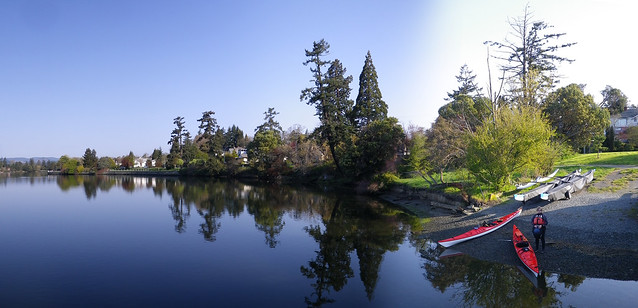
Any Friday that you can get on the water isn't just a Good Friday, it's a Great Friday. Louise and I rolled our kayaks down the hill to kayak in the Gorge. Sunny and reasonably warm -- could Spring have finally arrived?
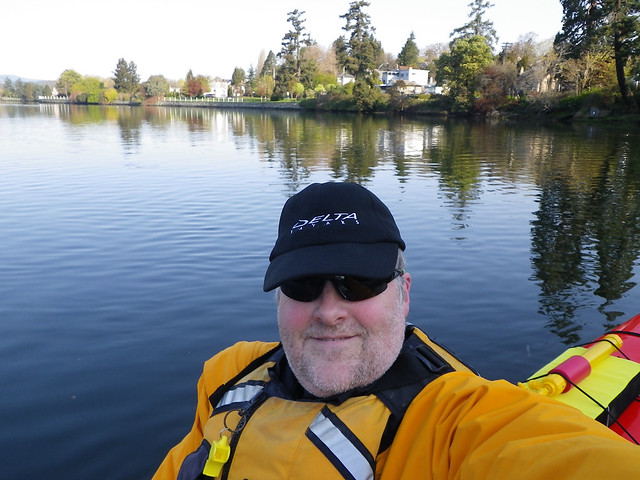
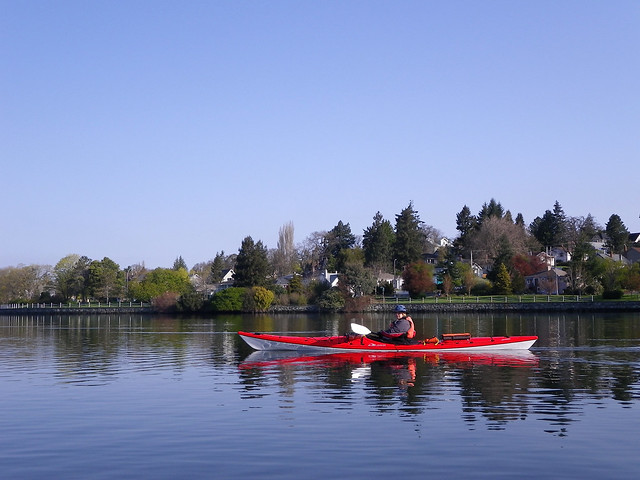
We headed up the Gorge towards Portage Inlet, accompanied by a flock of ducks....

...and it wasn't long before we spotted our first heron.

We passed what I like to call Cormorant Tree because it usually has a few cormorants sitting in it. And today was no exception.
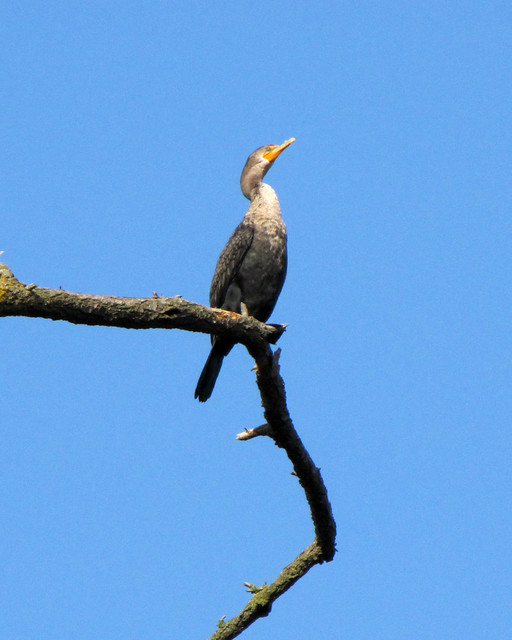
We moved on into Portage Inlet, looking for the local swans. We found one pair nesting in their usual spot as they do every year. We'll check back later in the spring and see how the chicks are doing.
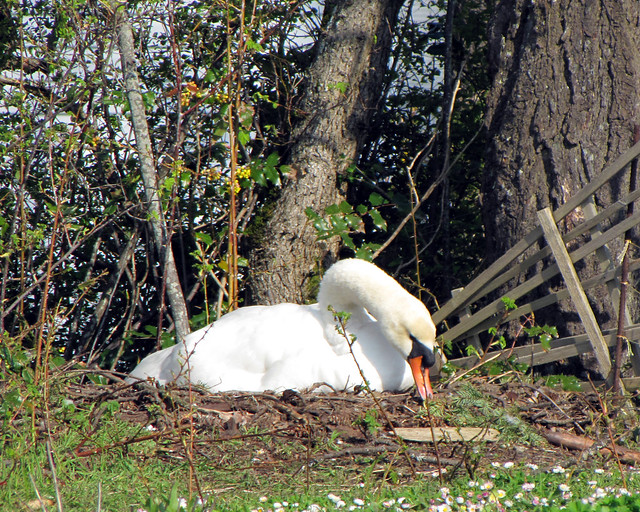
A few minutes later we saw what at first we thought was a strange-looking blue duck bobbing along the surface....
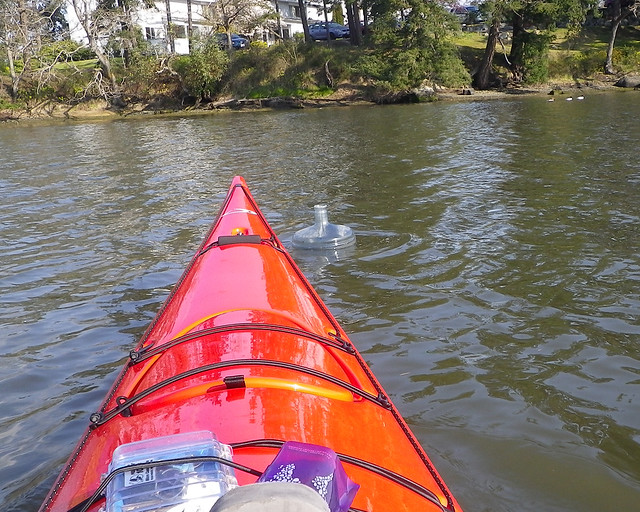
...but as we got closer we realized that it was a water bottle floating along. It took a little effort and teamwork...

... but we able to bring it ashore and empty it, thus performing our good deed for Earth Day.
We began our return...
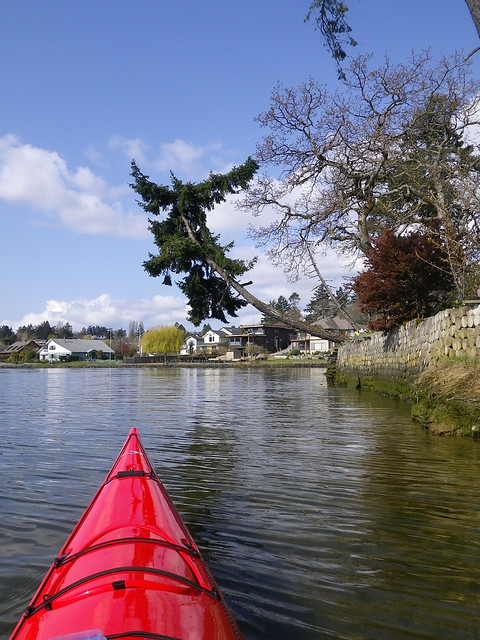
...and passed Cormorant Tree once again, but this time we saw a heron in the tree...

...and he was spending all his time scratching himself. That's not something you see everyday.
We saw one more heron, and this one assumed a more classic heron pose.
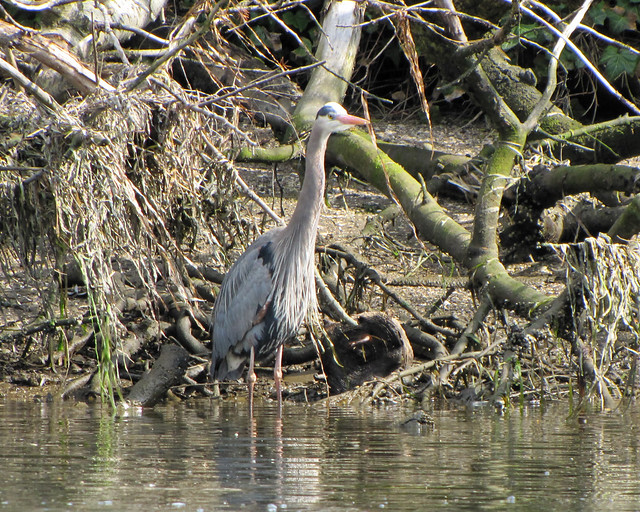
Then we had to roll the kayaks up the hill. Oh, joy.
Trip Length: 8.99 km
YTD: 50.92 km
More pictures are here.
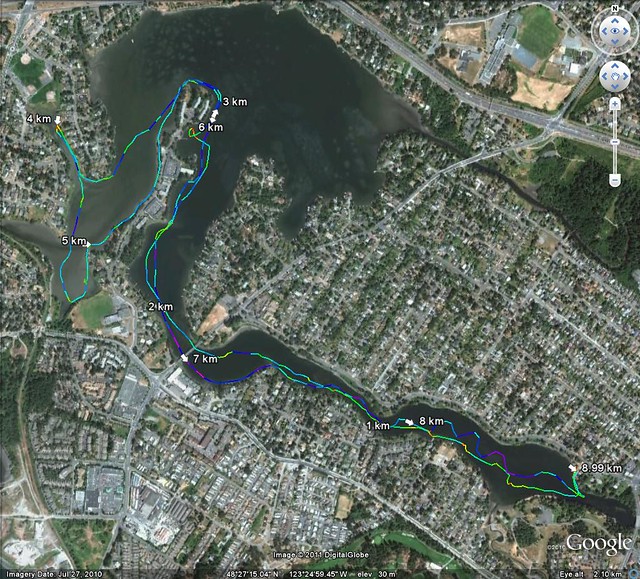
Labels:
cormorants,
ducks,
herons,
Portage Inlet,
swans,
The Gorge,
Victoria
Tuesday, April 19, 2011
Goldstream River Fuel Spill
The local news has been full of reports all weekend -- on Saturday, a fuel tanker truck crashed on the Island Highway in Goldstream Provincial Park. The tank was smashed, and released about 40,000 litres of gasoline into a culvert that drained into Goldstream River. Drunk driving charges are being contemplated against the driver.
The river is not a kayaking river, but the park is a popular recreational place with trails and a campground, and a wonderful Nature Centre looking over the Estuary. The news of the fuel spill into this beautiful river is heartbreaking.
Though it appears no humans died as a result of this crash, biologists are in the sad process of counting the number of salmon that died immediately and are still dying. At this point, it looks like every fish in the river below the fuel spill may have died. Some of the gasoline has already evaporated. There's no easy way to clean the gasoline out of the estuary, where the river drains into Finlayson Arm of Saanich Inlet. The fuel slick on the salt water of the inlet reached as far as the little marina in Finlayson Arm on Sunday.

This photo was taken by John during a day hike in Goldstream Provincial Park, in the fall when the chum salmon were spawning. A few days before the fuel spill, the Goldstream Hatchery had just released over 8,000 coho salmon fry into the river. The salmon enhancement program began thirty-five years ago. My friend Linda and I volunteered then with Howard English. We spent every Saturday for four years walking along this stretch of the river, feeding salmon fry.
There are more news articles online here. I haven't got the heart to write more about the fuel spill now.
The river is not a kayaking river, but the park is a popular recreational place with trails and a campground, and a wonderful Nature Centre looking over the Estuary. The news of the fuel spill into this beautiful river is heartbreaking.
Though it appears no humans died as a result of this crash, biologists are in the sad process of counting the number of salmon that died immediately and are still dying. At this point, it looks like every fish in the river below the fuel spill may have died. Some of the gasoline has already evaporated. There's no easy way to clean the gasoline out of the estuary, where the river drains into Finlayson Arm of Saanich Inlet. The fuel slick on the salt water of the inlet reached as far as the little marina in Finlayson Arm on Sunday.

This photo was taken by John during a day hike in Goldstream Provincial Park, in the fall when the chum salmon were spawning. A few days before the fuel spill, the Goldstream Hatchery had just released over 8,000 coho salmon fry into the river. The salmon enhancement program began thirty-five years ago. My friend Linda and I volunteered then with Howard English. We spent every Saturday for four years walking along this stretch of the river, feeding salmon fry.
There are more news articles online here. I haven't got the heart to write more about the fuel spill now.
Sunday, April 17, 2011
Back to the Water
It's been busy round here. Weddings and funerals, and life goes on. This past week I took my Occupational First Aid Level 2 course. How well did I do, I hear you ask? (Yes, my hearing is that good). I do my practical and written exams on Wednesday, so I'll find out then. It's probably good set of skills for a kayaker to have, although firing up a defibrillator on the water could be a shocking experience.
Spring weather has sucked around here. It's as if we went straight from winter right back to autumn again. But today dawned sunny (if cool) so Louise and I decided to ignore the cool weather and headed to Cadboro Bay to join Paula for a paddle.
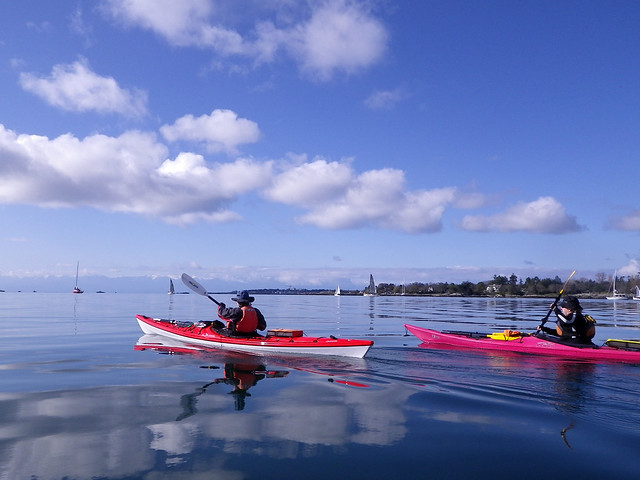
Richard was supposed to join us but there was no sign of him, so we headed out for a quick paddle to Chatham Island.
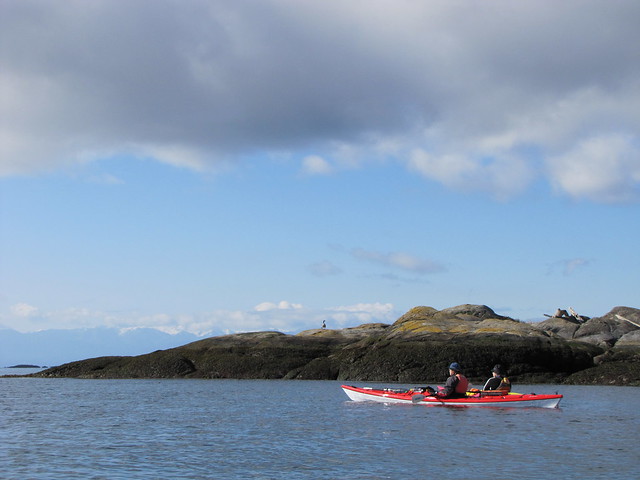
It needed to be quick for a number of reasons, among them the fact we were launching near slack, and the flood was expected to be a quick one. Also, although it was a sunny morning, there were isolated rain cells around. As we launched, we could see one off to the north-east, but it never came near us.
These oystercatchers were practising their Sunday morning yoga on Jemmy Jones Island.

We began our crossing to Chatham, but bailed on it halfway across. Paula's inner ear began to go wonky on her just as we encountered an odd eddy that came at us sideways and exacerbated her condition, and some sea lions were in the area feeding, and we decided to give them some space. We turned to head back to the mainland, content to putter through the nooks and crannies of Ten Mile Point.
But when we turned around, there was Richard heading off to Chatham Island! He'd picked a different line for his crossing, but he was only a couple of hundred metres away. We started calling him, but he didn't see us, and when we called, he didn't hear us, even when Louise gave her whistle a blow.
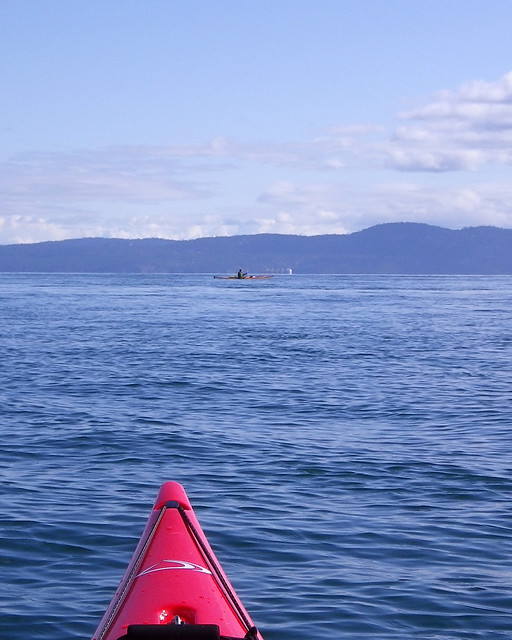
So there's a thought for you. If your shouts and whistles don't get attention on a perfectly calm day, will they on a stormy day?
We turned around at the Ten Mile Point light...
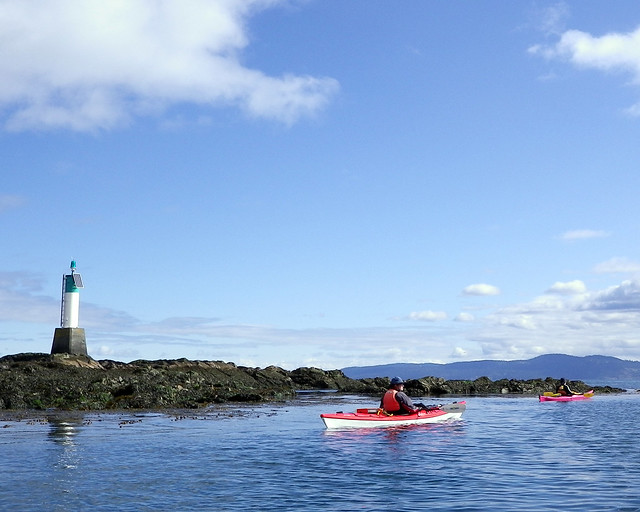
...and there was Richard!
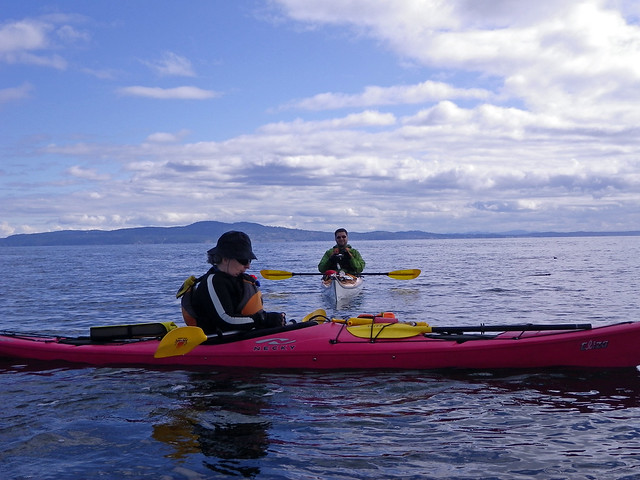
He'd spotted us moving up the coast as he crossed back from Chatham, and he confirmed for us that he hadn't heard us earlier. We began our return to Cadboro Bay and stopped for a moment...

...to watch the sail boats play in the bay.
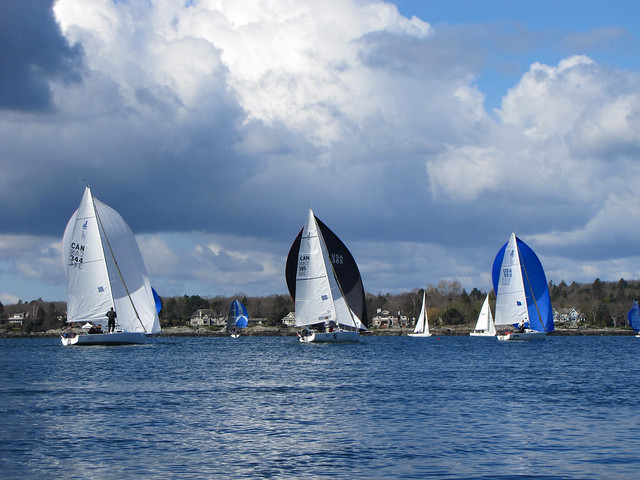
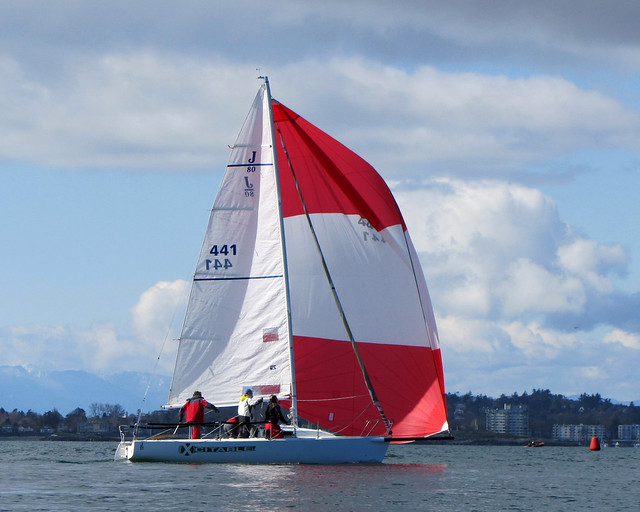
Trip Length: 8.52 km
YTD: 41.93 km
More pictures are here.
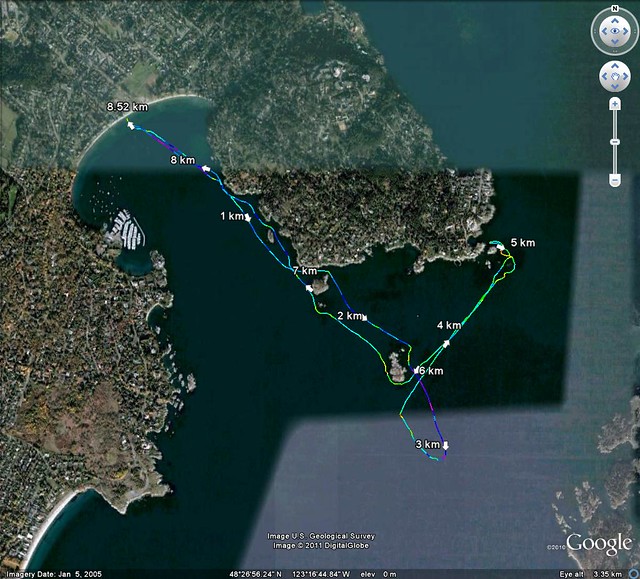
But wait -- there's more! After we landed and loaded up our gear, we headed down to the Inner Harbour for the "Celebration of Our Harbour" event to promote non-motorized uses of our harbour, and to continue the battle against the proposed mega-yacht marina.

There were races for various water craft, and we arrived just in time to see Mike Jackson win his kayak race...

...and do a victory roll.
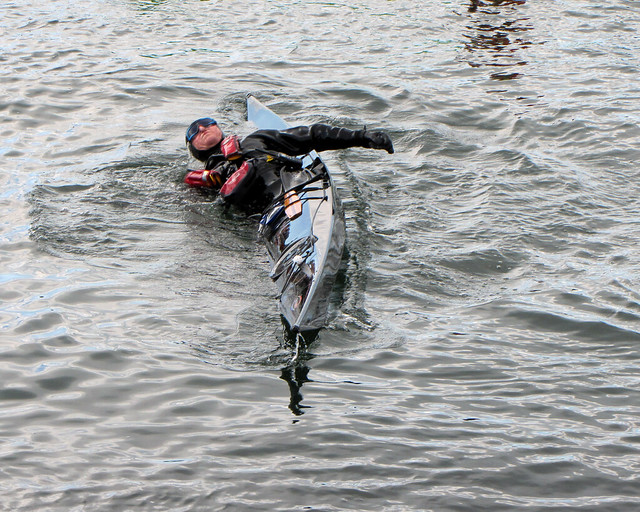
Spring weather has sucked around here. It's as if we went straight from winter right back to autumn again. But today dawned sunny (if cool) so Louise and I decided to ignore the cool weather and headed to Cadboro Bay to join Paula for a paddle.

Richard was supposed to join us but there was no sign of him, so we headed out for a quick paddle to Chatham Island.

It needed to be quick for a number of reasons, among them the fact we were launching near slack, and the flood was expected to be a quick one. Also, although it was a sunny morning, there were isolated rain cells around. As we launched, we could see one off to the north-east, but it never came near us.
These oystercatchers were practising their Sunday morning yoga on Jemmy Jones Island.

We began our crossing to Chatham, but bailed on it halfway across. Paula's inner ear began to go wonky on her just as we encountered an odd eddy that came at us sideways and exacerbated her condition, and some sea lions were in the area feeding, and we decided to give them some space. We turned to head back to the mainland, content to putter through the nooks and crannies of Ten Mile Point.
But when we turned around, there was Richard heading off to Chatham Island! He'd picked a different line for his crossing, but he was only a couple of hundred metres away. We started calling him, but he didn't see us, and when we called, he didn't hear us, even when Louise gave her whistle a blow.

So there's a thought for you. If your shouts and whistles don't get attention on a perfectly calm day, will they on a stormy day?
We turned around at the Ten Mile Point light...

...and there was Richard!

He'd spotted us moving up the coast as he crossed back from Chatham, and he confirmed for us that he hadn't heard us earlier. We began our return to Cadboro Bay and stopped for a moment...

...to watch the sail boats play in the bay.


Trip Length: 8.52 km
YTD: 41.93 km
More pictures are here.

But wait -- there's more! After we landed and loaded up our gear, we headed down to the Inner Harbour for the "Celebration of Our Harbour" event to promote non-motorized uses of our harbour, and to continue the battle against the proposed mega-yacht marina.

There were races for various water craft, and we arrived just in time to see Mike Jackson win his kayak race...

...and do a victory roll.

Friday, April 15, 2011
Osprey WebCam in Scotland
Anyone who has found the current crop of web cams in raptors' nests has a wonderful assortment of websites to cruise. Here's a link to another web cam -- this one is in an osprey nest near a Scottish loch.
Okay, it's not a kayaking site. But around here, we enjoy seeing the birds when we're out in our kayaks. John has many photos of bald eagles, and Rich has at least one of a golden eagle. I'm sure there's been an osprey or two among all the birds we thought were eagles.
The ospreys in Britain, on the other hand, are rare and endangered. That's why the one in the web cam nest is being celebrated. There's a great article on The Guardian's website, describing the birdwatchers' joy at seeing her return to her nest this spring. She's 26 years old, and that's old for a species that averages about 8 to 10 years in the wild. She has produced 48 offspring.
 I simply have to copy a photo here, from the Guardian website.
I simply have to copy a photo here, from the Guardian website.Impressed? She just laid her 59th egg. Staff at the Scottish Wildlife Trust are guarding her nest carefully.
Thursday, April 14, 2011
Let Go of My Fish!
Here's a clip of a kayak fisherman getting a little more action than he bargained for. Turns out the fish he just caught was also coveted by something else, and the caught fish gets ripped from his hand -- by a shark! Good thing he was wearing rubber pants!
Here's the clip:
Here's the clip:
Spring?
Yes, it's spring. There are flowers everywhere, not just snowdrops. Many of the blooming cherry trees are letting their petals fall. So why, when I was out on the water this morning, was it so cold? I had to wear a sweater over my shortie wetsuit. As I paddled past the little rock garden and out along the shore, I had to pull on my cold weather cap, a neoprene cap lined with thin fleece. Most of the time it's clipped inside my PFD, but at times like this morning's cold outing, it's wonderful to be able to pull it on. Sure, it makes my head look like a black egg. Or if I don't buckle the strap and the cap poufs up on top of my head (like most toques do, ya hoser) then I look like Bob or Doug McKenzie. Nevertheless, I prize my cold weather cap for (duh) cold weather. Besides, maybe the otters and seals think it makes me look more like them... I can't count on that idea, though. The first otter I saw this morning as I came around a little jut of land was diving into the water. This one I smelled before I saw it: a distinct scent of "used fish" common along this shore when the otters have climbing around on the rocks. The scent is distinct from that of cormorant droppings, which can also be described as "used fish" but with a definite note of "bird." The seal I saw took a moment to stare at me before dipping underwater, out in the channel between Flower Island and the main shore. I think this seal is the same one that I've often seen around here. She's been away for a couple of months, near as I can tell. It'll be neat to watch for her over the spring. Maybe this June she'll have another pup. By the time I saw Mama Seal, the stiff breeze blowing in off the strait had brought clouds to cover the sky. The chill wasn't so bad when I turned my back to the breeze and let the little waves push my inflatable back towards the beach. I found out a few minutes later, back at the Beach House, that there was snow this morning on the Malahat. Yep, it was April, but it was as cool this morning as some days we had in February.
Tuesday, April 12, 2011
Drugs from the Sea: 1. Cone snails and ziconotide
Drug discovery from marine sources is an active area of research, and several drugs of marine origin have already reached regular clinical use. (There's a whole journal dedicated to Marine Drugs. Open access, too). For quite some time, I've had the notion of doing a series of posts about these drugs, where they come from and what they do, and I've been tinkering with this first entry for about as long, trying to balance length with bio-geekery. So here goes.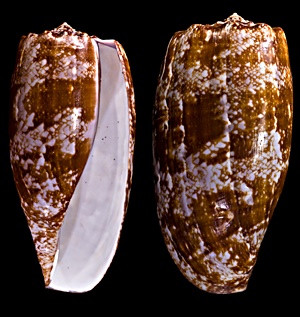
In 2004, the pain-killing drug ziconotide (Prialt) was approved for marketing by the US FDA, some twenty years after Balmedro Olivera and Lourdes Cruz set out to find out how the sting from a 10 cm poisonous marine snail, Conus geographus, could kill a human many times its weight. C geographus (picture from Wikimedia commons) is a member of the cone snail family, so named for their distinctively shaped, colourful shells. C. geographus takes its name from its map-like shell pattern (photo from Wikimedia commons). It lives below the low tide mark in pockets of sand near the edges of coral reefs and atolls; on a map its distribution tracks a wide ribbon from Madagascar around the edges of the Indian Ocean, down through Indonesia, around the North coast of Australia and up the islands and atolls of the Pacific. To the biologist, it and its fellows are known as Class Gastropoda, Order Neogastropoda, Superfamily Toxoglossa, Family Conidae, while naturalists over the centuries have named the Apothecary Cone, Astrologers Cone, Hebrew Cone and Emaciated Cone. The dinosaurs were already extinct when the first cone shell was pressed into the fossil record, some 55 million years ago, but they now form a family around 700 species strong, which inhabits warm and tepid shallows around the globe. The more common species can be had for a pleasure-dive in reef waters, or a stroll along the ocean, while particularly rare and handsome specimens have been auctioned for more than the price of a painting (in 1798) or a family saloon car (1960). Occasionally, their price has been a life: 30 or so people are known to have died of cone snail stings, mainly from Conus geographus.
Cone snails' dietary aspirations might seem, on first blush, overambitious: they are carnivorous, with a taste for worms, other molluscs ... and fish. However, per Ecclestiates, the race is not to the swift . . . Cone snails generally use one of two hunting strategies, harpoon or net, and their secret weapon is poison, a cocktail of venoms tailored to hunting style and prey. The cocktails contains 50-200 individual toxins, and vary between species, so that there are an estimated 25 000 plus toxins across all the known cone snail species. The venom of the harpoon-wielding snail Conus purpurascens contains a mixture of fast-acting toxins that produce a nerve paralysis, and slower acting toxins that produce muscular paralysis. When a fish comes within range, the snail jabs at it with a venom-filled tooth held on the end of a proboscis. A stung fish can be paralyzed within two seconds, its body rigid and its fins standing out as though shocked. One toxin jams open the sodium channel involved in the propagation of the nerve impulse [footnote i], a channel that ordinarily would close immediately to allow the membrane to reset itself. Another jams closed those potassium channels which normally would open to quench the depolarization. The membrane depolarizes, rapidly and completely, and nerve conduction stops. Even as this happens, a second, slower-acting set of toxins, acting on calcium channels, starts to paralyze the fish's muscles. They block sites to which signalling neurotransmitters bind, and sodium channels which would open in muscle contraction. Net-wielding snails, like Conus geographicus favour muscle paralytic toxins; since they first engulf their prey and then sting it, they can afford the slightly slower onset poison.
Contoxins are very small proteins, 10-35 amino acids long, and at their length would normally be a tumbling mixture of floppy conformations in solution rather than a fixed protein fold—Proteins depend on their ability to hold conformation to function. Conotoxins, however, take advantage of a property of the amino acid cysteine. Under the proper conditions, two cysteines in a peptide chain will link to each other, bringing their respective pieces of peptide chain into alignment. Conopeptides, small as they are, each have two or three pairs of cysteines, which cross-link to create a tight little package (3d structure of Ziconotide as the August 2006 molecule of the month at 3dchem). Since they are tightly folded, conotoxins waste neither time nor energy shifting into the right shape to bind to their target. There are two measures of quality of any interaction between molecules: how well a molecule discriminates between its own and all other binding sites, and how strongly it binds. By those measures, conotoxins are finely tuned, with certain conotoxins able to select between nerve cell sodium channels and muscle cell sodium channels, and others able to pick and chose between subtypes of calcium channel. Contoxins are several times more selective than peptides from snake and scorpion venoms. A measure of the strength of binding is the dissociation constant, a ratio of the amount of unbound toxins to the amount of bound toxin at a giving concentration; for the conotoxins those are of the order of 10(-9) or 0.000000001, or for every unbound toxin molecule, there are one trillion bound.
Drugs are often limited in their usefulness by side effects, some of which result from binding to molecular sites other than the target sites. For that reason, the conotoxin peptides, all 25 000-odd, with their strong, specific binding, are of great interest to scientists and several companies have investigated cone shell toxins as a source of drug candidates. Ziconotide (aka Prialt, from Elan Pharmaceuticals) is the first conotoxin-derived drug to pass successfully through all the stages of clinical drug development. It is a synthetic omega (calcium-channel binding) conotoxin from Conus magus, the Magician cone, which binds specifically to (calcium) channels in nerves in the spine which carry pain, and has proved effective in relieving pain for patients with intractable severe pain who either do not respond to or cannot tolerate other drugs. It’s not an opioid, therefore doesn't produce tolerance, and can be combined with other drugs. But it's still far from ideal: it has to be administered by intrathecal injection (directly into the fluid around the spine), which means it has to be given by an anaesthetist or by an implanted pump. The dose has to be increased slowly to decrease the risk of side effects, the onset of effect slow, response to dose changes is laggardly, and it can produce severe neurological and psychiatric side effects (Williams, 2008 PubMed abstract; Schmidtko, 2010 PubMed abstract).
To date, no other conotoxin-derived drugs have made it through clinical testing and into clinical use. Olivera in 2006 listed five in Phase I (first human) testing, mainly for pain, and their status in 2011 gives a snapshot of the vicissitudes of early phase drug development and the precarious life of small biotechnology companies: three of the companies involved appear to have either gone under or moved away from conotoxin development, and I am hard put to find evidence of progress on four of the compounds. The fifth (Xen-2174), which inhibits the uptake of the neurotransmitter norepinephrine, is in Phase II trials. Nevertheless, investigation continues; there are at least 24996 more conotoxins to go . . . A conotoxin derivative that can be taken orally has been developed. Conotoxins are being studied for their potential to protect brain tissue in stroke and heart muscle in heart attack, where part of the damage is known to be caused by uncontrolled leaks of ions across membranes [Twede et al, 2009 Full text]. And work with conopeptides has also identified other pathways involved in severe pain, leading to the development of non-conopeptide drugs directed at these pathways.
Footnotes and references.
[i] An aside on nerve conduction. It is orchestrated by the opening and closing of protein pores in the cell membrane of the neuron, which pass, according to their filter characteristics, sodium, potassium, or calcium ions. The sequence proceeds as follows: a trigger signal arrives, whether an electrical signal from another neuron, or a chemical signal. The membrane is held at a resting potential, a static voltage, with an excess of sodium outside the cell and potassium inside. When the impulse is triggered, sodium channels open, and sodium flows into the cell. The membrane depolarizes, losing its charge. Once the depolarization proceeds to a certain point, the sodium channels close, and potassium channels open, quenching the depolarization and allowing the membrane to reset to receive the next impulse. As each patch of nerve membrane is depolarized, it triggers depolarization of the next downstream; thus the impulse travels.

In 2004, the pain-killing drug ziconotide (Prialt) was approved for marketing by the US FDA, some twenty years after Balmedro Olivera and Lourdes Cruz set out to find out how the sting from a 10 cm poisonous marine snail, Conus geographus, could kill a human many times its weight. C geographus (picture from Wikimedia commons) is a member of the cone snail family, so named for their distinctively shaped, colourful shells. C. geographus takes its name from its map-like shell pattern (photo from Wikimedia commons). It lives below the low tide mark in pockets of sand near the edges of coral reefs and atolls; on a map its distribution tracks a wide ribbon from Madagascar around the edges of the Indian Ocean, down through Indonesia, around the North coast of Australia and up the islands and atolls of the Pacific. To the biologist, it and its fellows are known as Class Gastropoda, Order Neogastropoda, Superfamily Toxoglossa, Family Conidae, while naturalists over the centuries have named the Apothecary Cone, Astrologers Cone, Hebrew Cone and Emaciated Cone. The dinosaurs were already extinct when the first cone shell was pressed into the fossil record, some 55 million years ago, but they now form a family around 700 species strong, which inhabits warm and tepid shallows around the globe. The more common species can be had for a pleasure-dive in reef waters, or a stroll along the ocean, while particularly rare and handsome specimens have been auctioned for more than the price of a painting (in 1798) or a family saloon car (1960). Occasionally, their price has been a life: 30 or so people are known to have died of cone snail stings, mainly from Conus geographus.
Cone snails' dietary aspirations might seem, on first blush, overambitious: they are carnivorous, with a taste for worms, other molluscs ... and fish. However, per Ecclestiates, the race is not to the swift . . . Cone snails generally use one of two hunting strategies, harpoon or net, and their secret weapon is poison, a cocktail of venoms tailored to hunting style and prey. The cocktails contains 50-200 individual toxins, and vary between species, so that there are an estimated 25 000 plus toxins across all the known cone snail species. The venom of the harpoon-wielding snail Conus purpurascens contains a mixture of fast-acting toxins that produce a nerve paralysis, and slower acting toxins that produce muscular paralysis. When a fish comes within range, the snail jabs at it with a venom-filled tooth held on the end of a proboscis. A stung fish can be paralyzed within two seconds, its body rigid and its fins standing out as though shocked. One toxin jams open the sodium channel involved in the propagation of the nerve impulse [footnote i], a channel that ordinarily would close immediately to allow the membrane to reset itself. Another jams closed those potassium channels which normally would open to quench the depolarization. The membrane depolarizes, rapidly and completely, and nerve conduction stops. Even as this happens, a second, slower-acting set of toxins, acting on calcium channels, starts to paralyze the fish's muscles. They block sites to which signalling neurotransmitters bind, and sodium channels which would open in muscle contraction. Net-wielding snails, like Conus geographicus favour muscle paralytic toxins; since they first engulf their prey and then sting it, they can afford the slightly slower onset poison.
Contoxins are very small proteins, 10-35 amino acids long, and at their length would normally be a tumbling mixture of floppy conformations in solution rather than a fixed protein fold—Proteins depend on their ability to hold conformation to function. Conotoxins, however, take advantage of a property of the amino acid cysteine. Under the proper conditions, two cysteines in a peptide chain will link to each other, bringing their respective pieces of peptide chain into alignment. Conopeptides, small as they are, each have two or three pairs of cysteines, which cross-link to create a tight little package (3d structure of Ziconotide as the August 2006 molecule of the month at 3dchem). Since they are tightly folded, conotoxins waste neither time nor energy shifting into the right shape to bind to their target. There are two measures of quality of any interaction between molecules: how well a molecule discriminates between its own and all other binding sites, and how strongly it binds. By those measures, conotoxins are finely tuned, with certain conotoxins able to select between nerve cell sodium channels and muscle cell sodium channels, and others able to pick and chose between subtypes of calcium channel. Contoxins are several times more selective than peptides from snake and scorpion venoms. A measure of the strength of binding is the dissociation constant, a ratio of the amount of unbound toxins to the amount of bound toxin at a giving concentration; for the conotoxins those are of the order of 10(-9) or 0.000000001, or for every unbound toxin molecule, there are one trillion bound.
Drugs are often limited in their usefulness by side effects, some of which result from binding to molecular sites other than the target sites. For that reason, the conotoxin peptides, all 25 000-odd, with their strong, specific binding, are of great interest to scientists and several companies have investigated cone shell toxins as a source of drug candidates. Ziconotide (aka Prialt, from Elan Pharmaceuticals) is the first conotoxin-derived drug to pass successfully through all the stages of clinical drug development. It is a synthetic omega (calcium-channel binding) conotoxin from Conus magus, the Magician cone, which binds specifically to (calcium) channels in nerves in the spine which carry pain, and has proved effective in relieving pain for patients with intractable severe pain who either do not respond to or cannot tolerate other drugs. It’s not an opioid, therefore doesn't produce tolerance, and can be combined with other drugs. But it's still far from ideal: it has to be administered by intrathecal injection (directly into the fluid around the spine), which means it has to be given by an anaesthetist or by an implanted pump. The dose has to be increased slowly to decrease the risk of side effects, the onset of effect slow, response to dose changes is laggardly, and it can produce severe neurological and psychiatric side effects (Williams, 2008 PubMed abstract; Schmidtko, 2010 PubMed abstract).
To date, no other conotoxin-derived drugs have made it through clinical testing and into clinical use. Olivera in 2006 listed five in Phase I (first human) testing, mainly for pain, and their status in 2011 gives a snapshot of the vicissitudes of early phase drug development and the precarious life of small biotechnology companies: three of the companies involved appear to have either gone under or moved away from conotoxin development, and I am hard put to find evidence of progress on four of the compounds. The fifth (Xen-2174), which inhibits the uptake of the neurotransmitter norepinephrine, is in Phase II trials. Nevertheless, investigation continues; there are at least 24996 more conotoxins to go . . . A conotoxin derivative that can be taken orally has been developed. Conotoxins are being studied for their potential to protect brain tissue in stroke and heart muscle in heart attack, where part of the damage is known to be caused by uncontrolled leaks of ions across membranes [Twede et al, 2009 Full text]. And work with conopeptides has also identified other pathways involved in severe pain, leading to the development of non-conopeptide drugs directed at these pathways.
Footnotes and references.
[i] An aside on nerve conduction. It is orchestrated by the opening and closing of protein pores in the cell membrane of the neuron, which pass, according to their filter characteristics, sodium, potassium, or calcium ions. The sequence proceeds as follows: a trigger signal arrives, whether an electrical signal from another neuron, or a chemical signal. The membrane is held at a resting potential, a static voltage, with an excess of sodium outside the cell and potassium inside. When the impulse is triggered, sodium channels open, and sodium flows into the cell. The membrane depolarizes, losing its charge. Once the depolarization proceeds to a certain point, the sodium channels close, and potassium channels open, quenching the depolarization and allowing the membrane to reset to receive the next impulse. As each patch of nerve membrane is depolarized, it triggers depolarization of the next downstream; thus the impulse travels.
- Olivera BM. E.E. Just Lecture, 1996. Conus venom peptides, receptor and ion channel targets, and drug design: 50 million years of neuropharmacology. Mol. Biol. Cell. 1997 Nov;8(11):2101-2109.
- Olivera BM. Conus peptides: biodiversity-based discovery and exogenomics. J. Biol. Chem. 2006 Oct 20;281(42):31173-31177.
- Terlau H, Olivera BM. Conus venoms: a rich source of novel ion channel-targeted peptides. Physiol. Rev. 2004 Jan;84(1):41-68.
- Wikipedia on Conus species, Ziconotide, ion channel.
- ConoServer (peptide sequence and reference database).
Confessions of a Wave Warrior
In the 1980s, Eric Soares, together with other like-minded individuals, formed the Tsumani Rangers, a rag-tag collection of kayakers specializing in taking surfing and rock gardening to the edge and beyond.
Eric's new book, Confessions of a Wave Warrior, tells the story of his kayaking career, from childhood adventures to a stint in the navy, to discovering kayaking and the keen friendships he his forged in the paddling community through the years, and recovering from heart surgery. Soares presents his stories in an engaging and humerous style, almost as if he's sitting next to you in a pub and regaling you with his tall tales -- I can almost smell the ale and fried food. Along the way he drops in notions about his philosophy for life, and even lets other Rangers spin a yarn or two.
Perhaps not it's the most in-depth and detailed of kayaking books you'll read this year, but certainly one of the most enjoyable. Anyone who enjoys stories of kayakers taking it to the edge will enjoy this.
Eric's new book, Confessions of a Wave Warrior, tells the story of his kayaking career, from childhood adventures to a stint in the navy, to discovering kayaking and the keen friendships he his forged in the paddling community through the years, and recovering from heart surgery. Soares presents his stories in an engaging and humerous style, almost as if he's sitting next to you in a pub and regaling you with his tall tales -- I can almost smell the ale and fried food. Along the way he drops in notions about his philosophy for life, and even lets other Rangers spin a yarn or two.
Perhaps not it's the most in-depth and detailed of kayaking books you'll read this year, but certainly one of the most enjoyable. Anyone who enjoys stories of kayakers taking it to the edge will enjoy this.
Sunday, April 10, 2011
Harbour Celebration Sunday April 17
Here's a note forwarded from SISKA -- the South Island Sea Kayaking Association -- about next weekend's Celebration of our Harbour. This event is another practical way to demonstrate that a proposed MegaYacht Marina is not the best use for this public space in our harbour! When: Sunday, April 17th, 11:00am- 3:00pm Where: On land in front of the Songhees and on the water along the north shore of the harbour. Victoria Harbour Celebration Society is a group of human-powered advocates that will be hosting this first “Celebration of our Harbour” event. The group wishes to protect, celebrate and encourage safe use of our beautiful harbour. The vision is to have this become an annual event, with support from Tourism Victoria, clubs and businesses. This fun community event will have: · On land displays by the paddling and rowing clubs and companies that operate in Victoria harbour. The public can learn about the diversity of healthy, inexpensive, environmentally friendly recreational opportunities available to use in our beautiful working harbour. · Fun Citizen Exhibition Races for kayaks, canoes and rowing craft, starting with the outriggers at 11:30am. Everyone is invited to race! The sea kayak start time will be 12:10 with the start line at the Victoria Harbour Ferry wharf near Royal Quays. · David Anderson, ex-Olympic rower and ex-MP will be kayaking as well as speaking with the media. This is another opportunity to show the public and media how important safety and access through Victoria Harbour is to us as kayakers. There will be all the other human-powered craft there as well. · Let’s see a really good turnout from SISKA at this event! Volunteers are also needed to help with safety on the water. If you have a VHF radio and are willing to help, please contact Jennie Sutton at jsl50@shaw.ca or 250-592-6434. · Demonstration of different types of kayaks, rolling, etc. It would be good to have some Greenland style kayaks and paddles as well as the “regular” kayaks and Euro paddles. Hopefully some of the more skilled paddlers will demonstrate rolling, etc! Launch sites: Bamfield Park, Selkirk Waters, Esquimalt, VCKC, Kinsman Park, ORS dock, Songhees…contact Jennie Sutton if you need more information… See you there!
Saturday, April 09, 2011
Another Use For Kayaks
It was a marvellous morning when I tromped down to Gyro Park beach in Cadboro Bay, with my little inflatable kayak on my shoulder. You know the one... there are heaps of photos of it all over the Kayak Yak blog. Here's one photo John took at the rally against the proposed marina in the Inner Harbour.  And as I passed the parking lot, two large dogs leapt out from a large car and began sniffing all around the grass and a pole and then noticed me. And my kayak. And did a double-take. Well, you have to think of the meeting from their point of view. I was carrying the kayak on my shoulder, on the side facing them. To the dogs, I must have looked like some weird monster, perhaps in the shape of the National Film Board symbol (a giant eye with legs). Scent matters more to a dog, but the scent wouldn't have helped them. It was a mix of PVC rubbery boat and a shortie neoprene wetsuit that no longer freshens up when washed with Mirazyme. Gah, a weird rubbery sweaty monster that swayed around! I may even have grunted as my sandal slipped in the mud. No wonder they barked. No wonder they flinched back on their haunches and cowered, then advanced two steps. No wonder they growled and barked in the way that signals "Get back or I'll bite! I'm going to bite you NOW!" The monkey that lives in the back of my head had that kayak off my shoulder in an instant. (You know that monkey... we all have one. It's pretty quiet most of the time.) I held the kayak between me and the dogs in a grip that couldn't have been improved: fingers around the paddle that was velcro'ed to the side of the deck, thumbs inside the coaming pressing the inflated coaming against the paddle. I presented the smooth grey oval of the kayak hull to the advancing dogs. If those dogs bit, all they'd get would be a mouthful of PVC hull. And after shuffling that kayak across barnacled rocks, I was quite willing to let both dogs chew on it if necessary. Did I mention that they were a German shepherd cross and a Blue Heeler? Strong, aggressive things that put together weighed as much as me? But even as the monkey in the back of my head invented Kayak Martial Arts and put me into a Kung Fu stance, the frontal lobes were talking to the dogs. "Sit! Cut that out! I'm a person. Haven't you ever seen a boat? Come and smell it." Their owner came up then, apologizing and admitting that the one dog was a rescue and had never seen a boat before. We did a quick session of introducing the dog to the boat and by our conversation showing her that the world did in fact include smelly boat-rubber people and their toys. Then I went off and paddled on calm waters, spying baby otters and great blue herons and having a lovely time. Un-bitten. And apparently, a natural at Kayak Martial Arts.
And as I passed the parking lot, two large dogs leapt out from a large car and began sniffing all around the grass and a pole and then noticed me. And my kayak. And did a double-take. Well, you have to think of the meeting from their point of view. I was carrying the kayak on my shoulder, on the side facing them. To the dogs, I must have looked like some weird monster, perhaps in the shape of the National Film Board symbol (a giant eye with legs). Scent matters more to a dog, but the scent wouldn't have helped them. It was a mix of PVC rubbery boat and a shortie neoprene wetsuit that no longer freshens up when washed with Mirazyme. Gah, a weird rubbery sweaty monster that swayed around! I may even have grunted as my sandal slipped in the mud. No wonder they barked. No wonder they flinched back on their haunches and cowered, then advanced two steps. No wonder they growled and barked in the way that signals "Get back or I'll bite! I'm going to bite you NOW!" The monkey that lives in the back of my head had that kayak off my shoulder in an instant. (You know that monkey... we all have one. It's pretty quiet most of the time.) I held the kayak between me and the dogs in a grip that couldn't have been improved: fingers around the paddle that was velcro'ed to the side of the deck, thumbs inside the coaming pressing the inflated coaming against the paddle. I presented the smooth grey oval of the kayak hull to the advancing dogs. If those dogs bit, all they'd get would be a mouthful of PVC hull. And after shuffling that kayak across barnacled rocks, I was quite willing to let both dogs chew on it if necessary. Did I mention that they were a German shepherd cross and a Blue Heeler? Strong, aggressive things that put together weighed as much as me? But even as the monkey in the back of my head invented Kayak Martial Arts and put me into a Kung Fu stance, the frontal lobes were talking to the dogs. "Sit! Cut that out! I'm a person. Haven't you ever seen a boat? Come and smell it." Their owner came up then, apologizing and admitting that the one dog was a rescue and had never seen a boat before. We did a quick session of introducing the dog to the boat and by our conversation showing her that the world did in fact include smelly boat-rubber people and their toys. Then I went off and paddled on calm waters, spying baby otters and great blue herons and having a lovely time. Un-bitten. And apparently, a natural at Kayak Martial Arts.
 And as I passed the parking lot, two large dogs leapt out from a large car and began sniffing all around the grass and a pole and then noticed me. And my kayak. And did a double-take. Well, you have to think of the meeting from their point of view. I was carrying the kayak on my shoulder, on the side facing them. To the dogs, I must have looked like some weird monster, perhaps in the shape of the National Film Board symbol (a giant eye with legs). Scent matters more to a dog, but the scent wouldn't have helped them. It was a mix of PVC rubbery boat and a shortie neoprene wetsuit that no longer freshens up when washed with Mirazyme. Gah, a weird rubbery sweaty monster that swayed around! I may even have grunted as my sandal slipped in the mud. No wonder they barked. No wonder they flinched back on their haunches and cowered, then advanced two steps. No wonder they growled and barked in the way that signals "Get back or I'll bite! I'm going to bite you NOW!" The monkey that lives in the back of my head had that kayak off my shoulder in an instant. (You know that monkey... we all have one. It's pretty quiet most of the time.) I held the kayak between me and the dogs in a grip that couldn't have been improved: fingers around the paddle that was velcro'ed to the side of the deck, thumbs inside the coaming pressing the inflated coaming against the paddle. I presented the smooth grey oval of the kayak hull to the advancing dogs. If those dogs bit, all they'd get would be a mouthful of PVC hull. And after shuffling that kayak across barnacled rocks, I was quite willing to let both dogs chew on it if necessary. Did I mention that they were a German shepherd cross and a Blue Heeler? Strong, aggressive things that put together weighed as much as me? But even as the monkey in the back of my head invented Kayak Martial Arts and put me into a Kung Fu stance, the frontal lobes were talking to the dogs. "Sit! Cut that out! I'm a person. Haven't you ever seen a boat? Come and smell it." Their owner came up then, apologizing and admitting that the one dog was a rescue and had never seen a boat before. We did a quick session of introducing the dog to the boat and by our conversation showing her that the world did in fact include smelly boat-rubber people and their toys. Then I went off and paddled on calm waters, spying baby otters and great blue herons and having a lovely time. Un-bitten. And apparently, a natural at Kayak Martial Arts.
And as I passed the parking lot, two large dogs leapt out from a large car and began sniffing all around the grass and a pole and then noticed me. And my kayak. And did a double-take. Well, you have to think of the meeting from their point of view. I was carrying the kayak on my shoulder, on the side facing them. To the dogs, I must have looked like some weird monster, perhaps in the shape of the National Film Board symbol (a giant eye with legs). Scent matters more to a dog, but the scent wouldn't have helped them. It was a mix of PVC rubbery boat and a shortie neoprene wetsuit that no longer freshens up when washed with Mirazyme. Gah, a weird rubbery sweaty monster that swayed around! I may even have grunted as my sandal slipped in the mud. No wonder they barked. No wonder they flinched back on their haunches and cowered, then advanced two steps. No wonder they growled and barked in the way that signals "Get back or I'll bite! I'm going to bite you NOW!" The monkey that lives in the back of my head had that kayak off my shoulder in an instant. (You know that monkey... we all have one. It's pretty quiet most of the time.) I held the kayak between me and the dogs in a grip that couldn't have been improved: fingers around the paddle that was velcro'ed to the side of the deck, thumbs inside the coaming pressing the inflated coaming against the paddle. I presented the smooth grey oval of the kayak hull to the advancing dogs. If those dogs bit, all they'd get would be a mouthful of PVC hull. And after shuffling that kayak across barnacled rocks, I was quite willing to let both dogs chew on it if necessary. Did I mention that they were a German shepherd cross and a Blue Heeler? Strong, aggressive things that put together weighed as much as me? But even as the monkey in the back of my head invented Kayak Martial Arts and put me into a Kung Fu stance, the frontal lobes were talking to the dogs. "Sit! Cut that out! I'm a person. Haven't you ever seen a boat? Come and smell it." Their owner came up then, apologizing and admitting that the one dog was a rescue and had never seen a boat before. We did a quick session of introducing the dog to the boat and by our conversation showing her that the world did in fact include smelly boat-rubber people and their toys. Then I went off and paddled on calm waters, spying baby otters and great blue herons and having a lovely time. Un-bitten. And apparently, a natural at Kayak Martial Arts.
Tuesday, April 05, 2011
Road Kayaking
A local man got tired of not being able to kayak when his wife took the car to work, so he reconfigured a motorcycle side car to carry his kayak. Check out the story on the latest Ocean River Sports newsletter.
Sunday, April 03, 2011
Didn't Go Kayaking Today
Friday, April 01, 2011
Abbey Cove
 Our friend Bernie doesn't go out paddling much anymore, mostly because he's focusing on his new music career. He creates music either under the Leaves on Trees moniker or his own name, and he recently branched out and created an album of kayak-related Beatles covers. He calls the project Abbey Cove, and he recently gave us a quick interview on the subject.
Our friend Bernie doesn't go out paddling much anymore, mostly because he's focusing on his new music career. He creates music either under the Leaves on Trees moniker or his own name, and he recently branched out and created an album of kayak-related Beatles covers. He calls the project Abbey Cove, and he recently gave us a quick interview on the subject.The Beatles were known for their witty and often cryptic lyrics. You’ve chosen a more straightforward approach here. If I can quote one of your versions of a popular Beatles’ classic: “When I find myself in times of trouble my instructor comes to me, speaking words of wisdom...drop your knee.” Why did you decide to record a collection of kayak-related Beatles songs?
I was looking for a new project and I thought that this would combine my two great loves, kayaking and pop music. Originally I came up with an idea for a concept album about a long distance kayaking expedition. I wrote one song for it, With a Little Help From My Sponsors, but I couldn't make the idea work. So I decided to broaden the approach and use the entire Beatles oeuvre as source material.
This is a unique project. No one’s ever done anything like this before.
Thank you.
That wasn’t necessarily a compliment. What, if anything, have The Beatles had to say about this?
I haven't heard anything from them. Although the tires on my car got slashed last week and the police said it was done a by drum stick. Which is weird.
Tell us about some of the songs on the album. Can’t Buy Me Glove?
I have large hands. It’s a struggle to find any kayaking gloves that fit. And they're so expensive. Never mind that annoying extra finger on my left hand.
You’ve Got to Edge Your Boat Away?
It helps avoid the rocks.
Don’t Let Me Drown?
I was kayaking alone without a float plan in the ferry traffic up near Portland Island when I suffered an appendicitis attack on the water. Then my GPS batteries croaked, the fog rolled in, my paddle snapped in half, I hadn't taken my spare, my VHF radio was tucked in my rear hatch in a bag so I didn't hear the tsunami alert, my PFD was with my radio, a shark attacked me, and my compass fell overboard. Naturally, this was the one time that I didn't bother packing my charts or checking the weather forecasts or the posted tidal information. And I struck an iceberg. Fortunately my laptop was still working so I started writing it up as an article for Sea Kayaking Magazine right there on the water.
Fixing A Hole?
That one’s pretty self-explanatory. Thank goodness for duct tape!
All My Shoving?
Have you ever tried packing the front hatch on a Tahe Marine Greenland?
While My Paddle Gently Sweeps?
I think this is the highlight of the album. It's a very quick kayaking strokes lesson set to music. I go through the major strokes, and explain how to do them, all in 4/4 time. Do you know how hard it was to come up for a rhyme for "bow draw rudder"?
You used "cow's flawed udder." It doesn't really seem appropriate.
Do you have any other questions?
I understand your next project will be an album of kayak-related Who covers called Paddlephenia?
Yes, that’s right. I’ve already recorded one song called Won’t Get Pooled Again, a song about indoor practice sessions.
Finally, what kind of kayak do you paddle?
I have a sixteen foot Charlescraft that I built myself.
Hand made? We’re impressed! What is it made with?
Norwegian wood.
Of course.
Subscribe to:
Posts (Atom)



